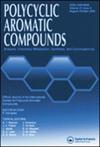通过DFT、分子动力学、分子对接和ADMET评估苯并硒二唑杂化物的反应性和抗癌潜力
IF 2.6
3区 化学
Q2 CHEMISTRY, ORGANIC
引用次数: 0
摘要
对抗癌症是具有挑战性的,但靶向细胞凋亡途径提供了希望。caspase 3和caspase 7切割底物,导致磷脂酰丝氨酸暴露、核浓缩和DNA断裂等关键特征,从而导致癌细胞死亡。这种认识有助于开发靶向疗法,选择性地消除癌细胞。本研究探讨了香芹酮-异恶唑-硒二唑类化合物(11a-e)作为潜在抗癌药物的合成、表征和硅分析。先进的核磁共振技术,包括COSY、HSQC和HMBC,证实了苯并[1-3]硒二唑核的结构完整性。其中,11c的HOMO-LUMO能隙较低,为3.2 eV,反应性较高。MEPS分析显示11c的生物活性位点在- 0.85和1.2 eV,而生物学评估显示11c通过caspase-3激活诱导细胞凋亡的能力,IC50为2.1 μM,与阿霉素相似。与凋亡相关蛋白的强对接相互作用进一步支持了这一点。成熟的caspase 3和7切割广泛的底物,最终导致凋亡的特征,如磷脂酰丝氨酸暴露、核缩聚和DNA断裂。ADMET分析显示药代动力学良好,logP为2.5,毒性风险低,LD50值为1000 mg/kg。结构-活性关系强调了硒在增强活性中的关键作用。11c具有强大的抗癌特性和有前景的药物特征,是进一步癌症治疗发展的引人注目的候选者。本文章由计算机程序翻译,如有差异,请以英文原文为准。
In-Silico Analysis of Benzo-Selenadiazole Hybrids: Reactivity and Anticancer Potential Assessed Through DFT, Molecular Dynamics, Molecular Docking, and ADMET
Fighting cancer is challenging, but targeting apoptosis pathways offers hope. Caspases 3 and 7 cleave substrates, leading to key features like phosphatidylserine exposure, nuclear condensation, and DNA fragmentation, driving cancer cell death. This understanding aids in developing targeted therapies to selectively eliminate cancer cells. This study explores the synthesis, characterization, and in-silico analysis of carvone-isoxazoline-selenadiazole hybrids (11a–e) as potential anticancer agents. Advanced NMR techniques, including COSY, HSQC, and HMBC, confirmed the structural integrity of the benzo[1–3]selenadiazole core. Among the derivatives, 11c stood out with a low HOMO-LUMO energy gap of 3.2 eV, indicating high reactivity. MEPS analysis revealed biologically active sites at −0.85 and 1.2 eV, while biological evaluations demonstrated 11c’s ability to induce apoptosis via caspase-3 activation with an IC50 of 2.1 μM, similar to doxorubicin. Strong docking interactions with apoptosis-related proteins further support this. Mature caspases 3 and 7 cleave a broad set of substrates, ultimately leading to apoptotic features such as phosphatidylserine exposure, nuclear condensation, and DNA fragmentation. ADMET analysis revealed favorable pharmacokinetics, with a logP of 2.5, and low toxicity risks, with an LD50 value of >1000 mg/kg. Structure-activity relationships highlighted selenium’s pivotal role in enhancing activity. With potent anticancer properties and a promising drug profile, 11c is a compelling candidate for further cancer therapy development.
求助全文
通过发布文献求助,成功后即可免费获取论文全文。
去求助
来源期刊

Polycyclic Aromatic Compounds
化学-有机化学
CiteScore
3.70
自引率
20.80%
发文量
412
审稿时长
3 months
期刊介绍:
The purpose of Polycyclic Aromatic Compounds is to provide an international and interdisciplinary forum for all aspects of research related to polycyclic aromatic compounds (PAC). Topics range from fundamental research in chemistry (including synthetic and theoretical chemistry) and physics (including astrophysics), as well as thermodynamics, spectroscopy, analytical methods, and biology to applied studies in environmental science, biochemistry, toxicology, and industry. Polycyclic Aromatic Compounds has an outstanding Editorial Board and offers a rapid and efficient peer review process, as well as a flexible open access policy.
 求助内容:
求助内容: 应助结果提醒方式:
应助结果提醒方式:


